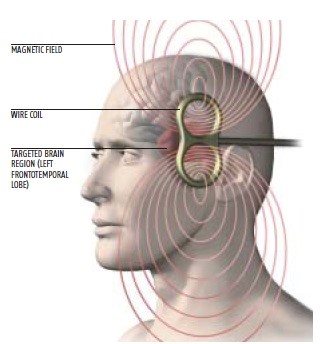TMS (Transcranial Magnetic Stimulation)
Transcranial Magnetic Stimulation (TMS) is a newly launched treatment modality for Neuro-Rehabilitation in Stroke. Transcranial stimulation of human brain is with proven clinical beneficial effects for Stroke-Rehabilitation.
TMS is non-invasive. It serves to stimulate both the normal and the injured brain cells to wake up, to recover, to replace for the lost, and possibly to regenerate. By doing so, the lost neurological functions of stroke patients are hopping to be recovered in a faster pace and in a more comprehensive way. In order to achieve the best treatment outcome, TMS for stroke patients has to be clinically applied in conjunction with other conventional Stroke-Rehabilitation Programs i.e. Physiotherapy, occupational and speech therapy, etc.
Through intact human skull bone, Transcranial Magnetic Stimulation (TMS) influences neuronal activity at our brains. The stimulation is caused by short magnetic pulses, with a field strength between 2 to 3 Tesla, similar to that of a magnetic resonance imaging (MRI) machine. During TMS treatment, a handheld Butterfly Coil applying over patient’s head will generate a precise and highly focused magnetic pulses. With the concept of electromagnetic induction in physic, a tiny electric current flow will then be induced at the targeted brain areas to activate brain cells.
Through intact human skull bone, Transcranial Magnetic Stimulation (TMS) influences neuronal activity at our brains. The stimulation is caused by short magnetic pulses, with a field strength between 2 to 3 Tesla, similar to that of a magnetic resonance imaging (MRI) machine. During TMS treatment, a handheld Butterfly Coil applying over patient’s head will generate a precise and highly focused magnetic pulses. With the concept of electromagnetic induction in physic, a tiny electric current flow will then be induced at the targeted brain areas to activate brain cells.
TMS treatment is safe and effective. The treatment does not require anesthesia or sedatives. Patient stays awake and conscious during treatment. During TMS, some patients may experience mild muscle twitching at face or hands. Some patients may have little transient discomfort, mild pain, tinnitus, minor disturbed neurological functions i.e. hearing and cognition, or even sense of faint. In 1/10000 cases, TMS may induce seizure attack during stimulation. The use of TMS should be with cautions in patients with implanted devices such as cardiac pacemakers or defibrillators
During treatment, the Neuro-Rehabilitation Specialist and Healthcare Team will ensure patient’s comfort and with risks minimized.
The clinical applications of TMS are also extended to other neurological diseases and mental health, i.e. dementia, anxiety disorder, depression, etc. Besides, TMS can be used clinically to measure the integrity, the activity and the function of specific brain circuits in humans. The most widely accepted application is for measuring the connection between the primary motor cortex of central nervous system at brain and the peripheral nervous system at spine or limbs, so as to evaluate the structural and functional damages related to past, present or progressive neurologic insults and diseases.
 |
Repeat Transcranial Magnetic Stimulation(rTMS)& Hand Therapy |
|
 |
||
 |
||
 |
TMS for Stroke Recovery |







